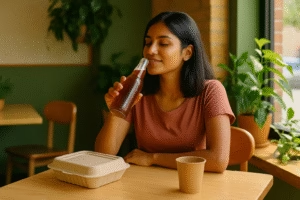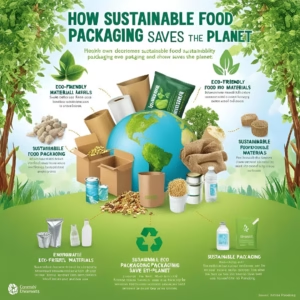By Vaibhav, Food safety Expert with 5+ Years Helping Brands Go Green | Published: April 25, 2025
Hey, Let’s Talk Sustainable Food Packaging!

Picture yourself at a cozy café, sipping a craft soda from a reusable glass bottle, or unpacking takeout in a compostable container. Sustainable packaging is everywhere these days, and it’s not just a feel-good trend—it’s reshaping the food and beverage world. With customers demanding greener choices and regulations like India’s FSSAI pushing for sustainability, businesses are asking: What’s the best packaging for my products?
I’m Vaibhav, and for over five years, I’ve helped food and drink brands—from startups to big names—switch to eco-friendly packaging that’s practical and planet-friendly. In this guide, I’ll walk you through the three big options: reusable, recyclable, and compostable packaging. We’ll cover what they are, their pros and cons, and which one fits your products, budget, and vibe. Whether you’re running a small bakery or just curious about greener choices, let’s dive in and find what works for you.
1. Reusable Packaging: The Long-Lasting Hero
What’s Reusable Packaging All About?

Think classic glass milk bottles or sturdy stainless steel takeout containers. Reusable packaging is built to be cleaned and used again—sometimes dozens or even hundreds of times. It’s like your trusty reusable coffee cup, but for food and drinks Sustainable Food Packaging.
Where You’ll See It
- Drinks: Glass bottles for milk, juice, or craft sodas
- Takeout: Metal or heavy-duty plastic containers
- Bulk Delivery: Crates for fresh veggies or bakery goods
How Sustainable Food Packaging Saves the Planet

- Long Life: These can last 50–100 uses, slashing waste by up to 80% compared to single-use packaging (thanks, Ellen MacArthur Foundation, 2023).
- Carbon Footprint: They take more energy to make, but over time, they’re a huge win for the environment.
Why It’s Awesome

- Keeps trash out of landfills by looping back into use
- Builds loyal customers with return programs
- Perfect for premium products that feel special
The Catch
- Can be pricey to produce and manage return systems
- Needs customers to bring containers back
- Not great for cheap, grab-and-go snacks
Sustainable Food Packaging Best For
- D2C brands with delivery systems (like milk or beverage subscriptions)
- Cafés or restaurants with “return your container” perks
- Liquids like milk, juice, or sauces
2. Recyclable Packaging: The Classic Choice
What’s Recyclable Packaging?

This is the stuff you toss in your recycling bin—cardboard cereal boxes, aluminum cans, or plastic water bottles (the recyclable kinds, like PET or HDPE). It gets collected, processed, and turned into something new.
Common Materials
- Cardboard: Pizza boxes, pasta packaging
- Aluminum: Soda or beer cans
- Plastics: Water bottles, yogurt tubs (but only certain types)
How Sustainable Food Packaging Saves the Planet
- Recycling Rates: Aluminum’s rocking it at 68% globally, cardboard’s at 50%, but plastics are stuck at just 9% (OECD, 2024).
- Energy Savings: Recycling a can uses 95% less energy than making a new one. That’s a big deal!
Why It’s Awesome
- Easy on the wallet and widely available
- Most people know how to recycle (or at least try)
- Works in cities with decent recycling programs
The Catch
- Food gunk can mess up the recycling process
- Not every place has strong recycling systems
- Wrong bin? It’s landfill-bound
Best For
- Dry foods like cereals, snacks, or pasta
- Drinks in cans or bottles
- Outer packaging like shipping boxes
Decision Matrix: Which Sustainable Food Packaging Wins?
| Criteria | Reusable | Recyclable | Compostable |
|---|---|---|---|
| Food Safety | ✅ Top-notch | ✅ Top-notch | ✅ Top-notch |
| Cost | ❌ Pricey upfront | ✅ Affordable | ❌ A bit pricey |
| Waste Reduction | ✅ Amazing | ✅ Pretty good | ✅ Amazing |
| Customer Familiarity | ❌ Still new | ✅ Everyone knows | ✅ Catching on |
| Works for Liquids? | ✅ Yes | ✅ Yes | ❌ Not always |
| Regulations | ✅ Growing | ✅ Rock-solid | ✅ Getting there |
How Do They Stack Up for the Planet?
- Reusable: The long-term champ, cutting waste by 80% over 50 uses. They’re energy-heavy to make, but they pay off big.
- Recyclable: Great where recycling works well (like aluminum at 68% globally). Food gunk or weak systems can hold it back.
- Compostable: Awesome for food-soiled packaging, going back to nature with zero waste—if you’ve got industrial composting nearby (only 30% of regions do, per UNEP, 2024).
Brands Doing It Right

Need some inspiration? These brands and initiatives are leading the way:
- Bacardi India: They’re all in on reusing glass bottles, partnering with collection agencies to gather used bottles, sanitize them, and refill them for their premium spirits. It’s a smart move that cuts waste and keeps their brand eco-chic.
- Reverse Cleantech (India): Companies like Return Bottle are revolutionizing reuse by collecting 1–2 lakh used alcoholic beverage bottles monthly from consumers, bars, and trade outlets. At their plants, bottles are washed and sanitized using eco-friendly clean-in-place methods, then sent to brands like Salud Beverages and others for refilling. Each bottle gets 6–7 lives, keeping lakhs of glass bottles out of landfills every month!
- Salud Beverages (India): Their returnable glass bottles for fizzy drinks cut waste by 70% through a deposit system. Customers love the eco-perk and the premium feel.
- Amul (India): Milk in recyclable plastic pouches or glass bottles—affordable and eco-conscious.
- Just Salad (USA): Their reusable bowl program slashes single-use plastic by 20% every year.
- Zomato (India): Testing compostable packaging for food delivery in select cities, winning over green-minded foodies.
Your Game Plan: How to Pick the Right Sustainable Food Packaging
Choosing Sustainable Food Packaging can feel like a lot, but here’s a simple plan to nail it:
-
Know Your Product:
-
Liquids? Go reusable or recyclable.
-
Fresh produce or takeout? Compostable’s your friend.
-
-
Check Your Area:
-
Got strong recycling? Lean recyclable.
-
Industrial composting nearby? Compostable’s a win.
-
-
Think About Your Customers:
-
Will they return containers? Reusable could work.
-
Love eco-vibes? Compostable screams “green.”
-
-
Balance Cost and Branding:
-
Tight budget? Recyclable’s wallet-friendly.
-
Premium brand? Reusable says “high-end.”
-
FAQs: Your Questions, Answered
Is compostable packaging always better than recyclable?
Not really. Compostable stuff needs industrial composting facilities, which aren’t everywhere. If it lands in a landfill, it’s no better than plastic. Recyclable packaging wins where recycling systems are strong.
Can I mix and match packaging types?
Absolutely! Lots of brands use recyclable outer boxes with compostable liners inside. It’s a smart way to keep things clean and eco-friendly.
Does this Sustainable Food Packaging meet FSSAI rules?
Yes! All three types are FSSAI-approved as long as they’re made from safe, non-toxic materials. Compostable ones need to meet IS/ISO 17088 standards to prove they break down properly.
How should customers toss these out?
-
Reusable: Wash and return to the store or brand.
-
Recyclable: Rinse and pop in the recycling bin (check local rules).
-
Compostable: Send to industrial composting or use a home compost if it’s compatible.
Want More Tips?
Check out these reads on FoodTechZone:
Dig Deeper with These Resources
Wrap-Up: Make Your Packaging a Win for the Planet
Going sustainable isn’t just about following rules—it’s about standing out, saving money over time, and showing your customers you care about the planet. Whether you choose reusable, recyclable, compostable, or a mix, the right pick depends on your products, your customers, and what’s available in your area.
Want to stay in the loop on sustainable food packaging? Join FoodTechZone’s Newsletter for fresh tips and trends.
